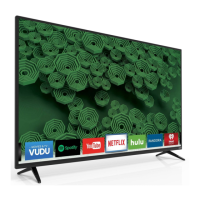
Do you have a question about the Vizio D55u-D1 and is the answer not in the manual?
| Screen shape | Flat |
|---|---|
| Response time | - ms |
| Display diagonal | 54.6 \ |
| Display brightness | - cd/m² |
| Native aspect ratio | 16:9 |
| LED backlighting type | Full-Array |
| Supported video modes | 1080p, 2160p |
| Contrast ratio (dynamic) | 5000000:1 |
| Display refresh rates supported | 120 Hz |
| Motion interpolation technology | - |
| Music apps | Pandora, Spotify |
| Video apps | Netflix, YouTube |
| Lifestyle apps | Facebook, Twitter |
| Audio decoders | DTS Studio Sound |
| RMS rated power | 10 W |
| Number of speakers | 2 |
| PC in (D-Sub) | No |
| HDMI ports quantity | 5 |
| DVI-D ports quantity | 0 |
| USB 2.0 ports quantity | USB 2.0 ports have a data transmission speed of 480 Mbps, and are backwards compatible with USB 1.1 ports. You can connect all kinds of peripheral devices to them. |
| Ethernet LAN (RJ-45) ports | 1 |
| Wi-Fi standards | Wi-Fi 5 (802.11ac) |
| Number of OSD languages | 3 |
| On Screen Display (OSD) languages | ENG, ESP, FRE |
| Product color | Black |
| Panel mounting interface | 300 x 300 mm |
| AC input voltage | 120 V |
| AC input frequency | 60 Hz |
| Power consumption (standby) | 0.5 W |
| Power consumption (typical) | 82.4 W |
| Package depth | 162 mm |
| Package width | 1357 mm |
| Package height | 821.9 mm |
| Package weight | 21000 g |
| Sustainability certificates | ENERGY STAR |
| Certification | UL, cUL, FCC Class B, HDMI 1.4/2.0, Dolby Digital Plus |
| Depth (with stand) | 255 mm |
|---|---|
| Height (with stand) | 781 mm |
| Weight (with stand) | 17000 g |
| Depth (without stand) | 64.01 mm |
| Width (without stand) | 1239 mm |
| Height (without stand) | 721.1 mm |
| Weight (without stand) | 16600 g |
Essential safety guidelines for operating the TV, including warnings and precautions.
Safety measures to protect the TV during lightning storms and when unattended.
Verify all items are present and undamaged before installation.
Identification of components and indicators on the front of the TV.
Identification of ports and connectors on the back of the TV.
Instructions for attaching the TV stand securely to the TV.
Steps for mounting the TV onto a wall using a bracket.
Guide on how to safely replace batteries in the remote control.
General procedure for connecting external devices to the TV.
Explanation of different cable types for audio and video connections.
Specific instructions for connecting audio devices and their cable types.
Steps to connect the TV to your network using an Ethernet cable.
Steps to connect the TV to your network using a Wi-Fi connection.
Locating the TV's MAC addresses for network configuration.
Connecting to a wireless network without a broadcasted name (SSID).
Verifying the TV's network connection status and speed.
How to navigate and interact with the TV's on-screen menu system.
Procedure to select the active input source for connected devices.
Fine-tuning picture settings, including color temperature presets.
Creating and saving personalized picture settings profiles.
Securing custom picture settings with a PIN.
Customizing audio output with equalizer presets or custom modes.
Configure sleep timer and auto power off for energy saving.
Activate screen saver and blank screen features for energy conservation.
Steps to connect the TV to your network using a Wi-Fi connection.
Locating the TV's MAC addresses for network configuration.
Connecting to a wireless network without a broadcasted name (SSID).
Verifying the TV's network connection status and speed.
Performing an automatic scan to find available TV channels.
Adding specific channel ranges or analog channels.
Removing unwanted channels from the TV's memory.
Selecting alternate audio languages for analog and digital broadcasts.
Customizing the look and feel of digital closed captions.
Accessing technical data and status information about the TV.
Selecting the preferred language for the TV's on-screen interface.
How to access and manage parental control features.
Settings for locking channels, blocking by rating, and changing PIN.
Resetting all TV settings to their original factory configurations.
Managing the TV's ability to display program-related broadcast information.
How to play music, videos, and photos from a USB drive.
Safe procedure for disconnecting a USB drive from the TV.
Accessing and launching applications via the V.I.A. Plus App Dock.
Installing new applications from the app store to your TV.
Removing installed applications from your TV.
Organizing and repositioning applications within the My Apps tab.
Explanation of Ultra HD resolution and its benefits for viewing.
Requirements for viewing Ultra HD content, including hardware and connections.
Details on HDMI 2.0 and HDCP 2.2 technologies for Ultra HD playback.
Solutions for common TV problems like no signal, no sound, or remote issues.